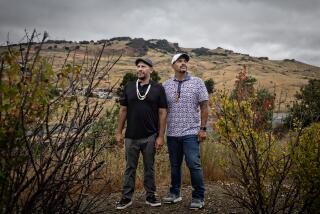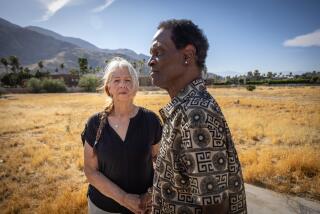Tribal Rift Is a Matter of Blood
- Share via
SEMINOLE, Okla. — It was blood and money that fractured the Seminole nation and started the siege. A tense battle of wills between two men--each of whom swears he is the rightful head of the 12,000-member Seminole nation--paralyzed this smattering of gambling halls and old meeting grounds for more than a week.
Longtime chief Jerry Haney is recognized by the U.S. government, even though he lost the last election by a wide margin. His wildly popular foe, Kenneth Chambers, has managed to cling to power ever since he triumphed in a racially charged and illegal election last summer.
The two sides spent the last week staring each other down across a country road--neither wanted to relinquish the tribal buildings he had seized. Threats gave way to physical scuffles. Haney backed down late Tuesday, and tensions were easing slightly. The bustling casinos and shops reopened Wednesday night after having been closed for days.
“This has devastated our nation; it’s one of the lowest points in our history,” said Michael Haney. A pigtailed supporter and relative of Jerry Haney, Michael Haney pored over court orders in a smoky backroom of the tribal mission last weekend. “It’s family against family. Our morale is broken.”
The two factions can’t even agree on what started what Haney calls “this war--I mean, this conflict.” It was a long-simmering racial split that brought the Seminoles into chaos--but it’s a thirst for power and self-determination that lends the standoff its stubborn longevity. The two men stand to gain plenty: 150 years after the U.S. government pushed their ancestors out of Florida and onto the wilds of the Oklahoma prairies, the Seminole nation is worth millions of dollars and controls a burgeoning betting industry.
Things got messy two years ago, when the tribal council agreed to strip away the voting rights of approximately 2,000 black Seminoles. The so-called Freedmen are slaves’ descendants who have coexisted and mingled with the indigenous “blood Seminoles” for decades.
To indigenous Seminoles, the change in blood requirement was a stroke of self-determination. To the black Seminoles, it was a painful crack at their culture.
“My heart is just really, really heavy that these folks have so much hatred when their own ancestors did not have it,” black Seminole Lena J. Hunt Shaw said. “People of African descent played a major role, I mean a major role, in helping those Indians survive. Everybody has the blood in them.”
The Bureau of Indian Affairs failed to return numerous phone calls for this story, but the U.S. government appears to agree with Shaw. The federal agency regards the disenfranchisement of the Freedmen as an illegal maneuver, a constitutional amendment that took place without the needed approval of the Bureau of Indian Affairs. All tribal council business that fell after the decision to oust the black Seminoles is nullified, the bureau has told the Seminole leaders.
That includes the August election of Chambers, who spent this past week holed up in the tribal compound in blatant defiance of a tribal court order. As dusk gave way to torrential rain this weekend in the tiny town of Wewoka, children raced in the corridors. Old men in work boots rested against the walls.
The families who stayed loyal to Chambers lived on hot corn stew and sandwich cookies delivered by the tribal elders. They slept in cars and tents pitched in the grass; they took turns standing sentry. No matter what, they said, they would not leave.
And as it turned out, they didn’t have to. The siege ended late Tuesday, when a tribal appeals panel overturned the order that had banned Chambers from the Seminole offices. The panel ruled that a tribal judge had overstepped his authority when he froze the tribe’s bank accounts and disarmed the Lighthorsemen, the Seminole police.
But the bitter fight over Seminole leadership still has the nation crackling with tension. The federal government will continue trying to force the Seminoles to hold a new election--and count the votes of the Freedmen. Federal programs have ground to a stop, one by one, for months: meals for elderly, Head Start, transportation to and from dialysis treatments. Graduates have been unable to pin down scholarship funds; families have applied for emergency food stamps.
“People are getting hurt physically, they’re getting hurt financially,” Chambers supporter Marsey Harjo said. “Oh, yeah. It’s hit us hard.”
Chambers says he has no ethical choice but to defy the U.S. government and the Haney group. He says it’s a question of sovereignty, not race. His followers are fighting for the right to decide who is and is not Seminole, to pen their own constitution, and to pick their leaders.
“We’re a sovereign nation. Our government was here before the U.S. government,” Chambers said. “If we hold our ground we’ll win.”
Jerry Haney was chief for 12 years before losing to Chambers. The U.S. government says he’s still in charge, and Haney agrees. He and a handful of followers spent last week hunkered down in the Mekusukey tribal grounds, a high, breezy stretch of land with a meeting hall and a wide view of the rolling pastures below. They have the formal recognition of federal authorities--and not much else. Chambers sneers at them and calls them stooges for a meddling U.S. government.
After Tuesday night’s ruling restored guns to the Lighthorsemen, Haney fled the meeting hall and took refuge in his house. The tribal police remain loyal to Chambers, and Haney feared an attack.
“I knew it was going to come to a physical confrontation, and we don’t need that,” Haney said. “I vacated peacefully.”
For days, Chambers’ men hunched in folding chairs at the threshold of the Seminole bingo hall across the street from the Haney group. The two factions sat stolidly, glowering at their foes through binoculars, each one silently daring the other to cross the road. When a Chambers supporter crossed, a melee broke out. Rick Deer ended up in the hospital, beaten bloody by a crowd that included his cousin. Three people were arrested by Bureau of Indian Affairs agents, the only law enforcement allowed on tribal property.
Although the leaders insist they were fighting for freedom, not race, the men on sentry this week told a different tale.
“We’re not black--we’re Indians,” said blood Seminole Yogi Harjo, who drove out from Oklahoma City to help Chambers stake out the bingo hall. His hair is woven into three braids; an eagle feather flaps from the back of his Hilfiger cap. “We’re trying to keep the black people out.”
The origin of the black Seminoles is a point of dispute. Some of the tribe say the bloods and blacks banded together for protection back in the days before the United States shoved the Seminoles out of Florida. Others say the Seminoles kept slaves, who were freed and granted citizenship after the Civil War. Most likely, the truth is somewhere in between, says University of Oklahoma Native American studies professor Jerry C. Bread.
“But [the Seminole standoff] is really not a matter of race; it’s a matter of politics and the right of the people to define their own blood,” Bread said. “This is just the beginning of a trend that we’ll see across the country. How far do we go in allowing the U.S. government to dictate the rights that we have?”
The U.S. government has said the black Seminoles have been members since the tribe signed an 1866 treaty and can’t be kicked out without the approval of Congress.
The move to oust the black Seminoles came just as tribal politics became high-stakes. The federal government had paid the Seminoles back for the loss of Florida with a $35-million settlement. The advent of bingo halls and slot machines dropped millions of dollars into tribal coffers.
“It’s ethnic cleansing, revisionist history,” said Jonathon Velie, a lawyer for the Freedmen. “They’re out of control.”
Times researcher Lianne Hart contributed to this report.
More to Read
Sign up for Essential California
The most important California stories and recommendations in your inbox every morning.
You may occasionally receive promotional content from the Los Angeles Times.










